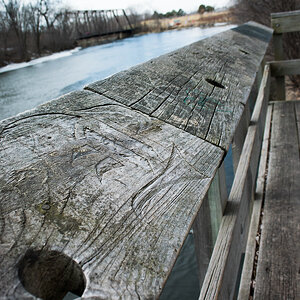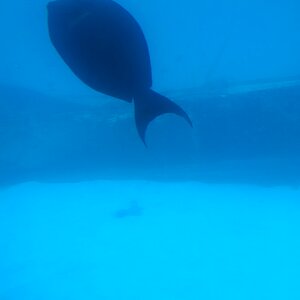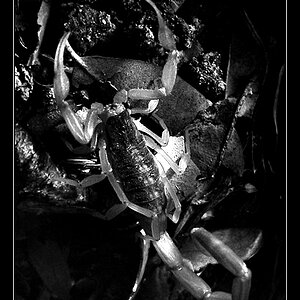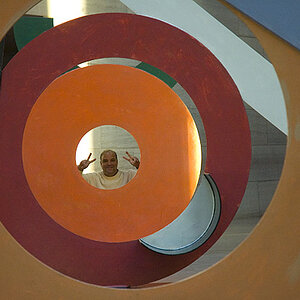First off, hello. I'm hoping you guys can help me understand this "photography thing" a little bit better, since I know very little about it.
My camera is certainly not a professional one (SLR or DSLR, though I'm DEFINITELY thinking about getting one), but a Canon SD900. I got it about a year and a half ago. It's a great point and shoot camera, in my opinion anyway - I've somehow managed to take some pretty interesting pictures with it that I thought were beyond its scope. But I've also taken some really, really horrible ones - which is why I'm here. I took several night shots that turned out SUPER grainy... Just... Horrible.

How horrible is that? Bleh
Maybe it's a camera limitation, but I was wondering is there's particular adjustments one can make for night shots.
It takes great day/high light pictures:

It took me a long time to figure out even how to accomplish halfway decent pictures like that. I'm a computer technician - I'm not stranger to technology, I just can't seem to comprehend how to make the pictures sharp though, consistently. The LCD on the images fool you into thinking the overall quality is great, yet when transferred to a computer you can really look at them under a microscope and there's alot of flaws.
This is one of the only low-light shots that managed to come out even remotely well:

I know it's kind of stupid to try to ask for model-specific advice when there's a myriad of P&S cameras, but some of its settings, photographically speaking, confuse me. For instance: "Foliage Mode", in the scene modes, somehow increases the shutter speed (or something... I may be getting ahead of myself in vernacular) and actually allows me to capture some action shots where I couldn't figure out how to get decent action shot in manual mode (plus, who can risk missing an action shot and getting a crummy image, instead of going with a scene mode that you know will atleast work somewhat-well?). This was taken at about 75mph on the highway:

Again, foliage mode. Because I couldn't figure out how to more accurately get the picture without blurring and such in manual mode and I didn't want to risk missing it. or maybe I'm just expecting way too much out of a P&S camera - or another possibility: I'm supposed to go through a little photo editting to make my pictures look the way I want them to. That's a whole different can of worms that I don't want to tinker with quite yet.
or maybe I'm just expecting way too much out of a P&S camera - or another possibility: I'm supposed to go through a little photo editting to make my pictures look the way I want them to. That's a whole different can of worms that I don't want to tinker with quite yet.
My last question is this: my camera gives me several resolution sizes to choose from when taking the picture; L (3648x2736), M1 (2816x2112), M2 (2272x1704), M3 (1600x1200), then there's small, postcard and widescreen. Then on top of that there's options for "Superfine", "Fine" and "Normal". My default choices for these is M3 on "Fine". But I can really only assume that this is resolution and sharpness. I didn't want to set either too high in case it added a delay or even blurring for action shots. Any suggestions on this or should I leave it alone?
Or maybe some has some simple photo editing tips/procedures I should run through with all of my photos?
Anyway, sorry for my lengthy post and noobish questions, lack of proper vocabulary and otherwise noobish camera. Hopefully someone can take a stab at a few of these.
Thanks!
Jordan
My camera is certainly not a professional one (SLR or DSLR, though I'm DEFINITELY thinking about getting one), but a Canon SD900. I got it about a year and a half ago. It's a great point and shoot camera, in my opinion anyway - I've somehow managed to take some pretty interesting pictures with it that I thought were beyond its scope. But I've also taken some really, really horrible ones - which is why I'm here. I took several night shots that turned out SUPER grainy... Just... Horrible.

How horrible is that? Bleh
Maybe it's a camera limitation, but I was wondering is there's particular adjustments one can make for night shots.
It takes great day/high light pictures:

It took me a long time to figure out even how to accomplish halfway decent pictures like that. I'm a computer technician - I'm not stranger to technology, I just can't seem to comprehend how to make the pictures sharp though, consistently. The LCD on the images fool you into thinking the overall quality is great, yet when transferred to a computer you can really look at them under a microscope and there's alot of flaws.
This is one of the only low-light shots that managed to come out even remotely well:

I know it's kind of stupid to try to ask for model-specific advice when there's a myriad of P&S cameras, but some of its settings, photographically speaking, confuse me. For instance: "Foliage Mode", in the scene modes, somehow increases the shutter speed (or something... I may be getting ahead of myself in vernacular) and actually allows me to capture some action shots where I couldn't figure out how to get decent action shot in manual mode (plus, who can risk missing an action shot and getting a crummy image, instead of going with a scene mode that you know will atleast work somewhat-well?). This was taken at about 75mph on the highway:

Again, foliage mode. Because I couldn't figure out how to more accurately get the picture without blurring and such in manual mode and I didn't want to risk missing it.
My last question is this: my camera gives me several resolution sizes to choose from when taking the picture; L (3648x2736), M1 (2816x2112), M2 (2272x1704), M3 (1600x1200), then there's small, postcard and widescreen. Then on top of that there's options for "Superfine", "Fine" and "Normal". My default choices for these is M3 on "Fine". But I can really only assume that this is resolution and sharpness. I didn't want to set either too high in case it added a delay or even blurring for action shots. Any suggestions on this or should I leave it alone?
Or maybe some has some simple photo editing tips/procedures I should run through with all of my photos?
Anyway, sorry for my lengthy post and noobish questions, lack of proper vocabulary and otherwise noobish camera. Hopefully someone can take a stab at a few of these.
Thanks!
Jordan
Last edited:



![[No title]](/data/xfmg/thumbnail/42/42019-e6f4e7422d2f8ec66dade714c8b21766.jpg?1619739979)

![[No title]](/data/xfmg/thumbnail/42/42023-bdd979ff50e78cc28479297780caeb90.jpg?1619739981)




![[No title]](/data/xfmg/thumbnail/34/34144-52e7a5d3e3908ae808afeabfe86fffdc.jpg?1619736317)
![[No title]](/data/xfmg/thumbnail/34/34142-948c6bafdf60862125009004d5a06e46.jpg?1619736315)